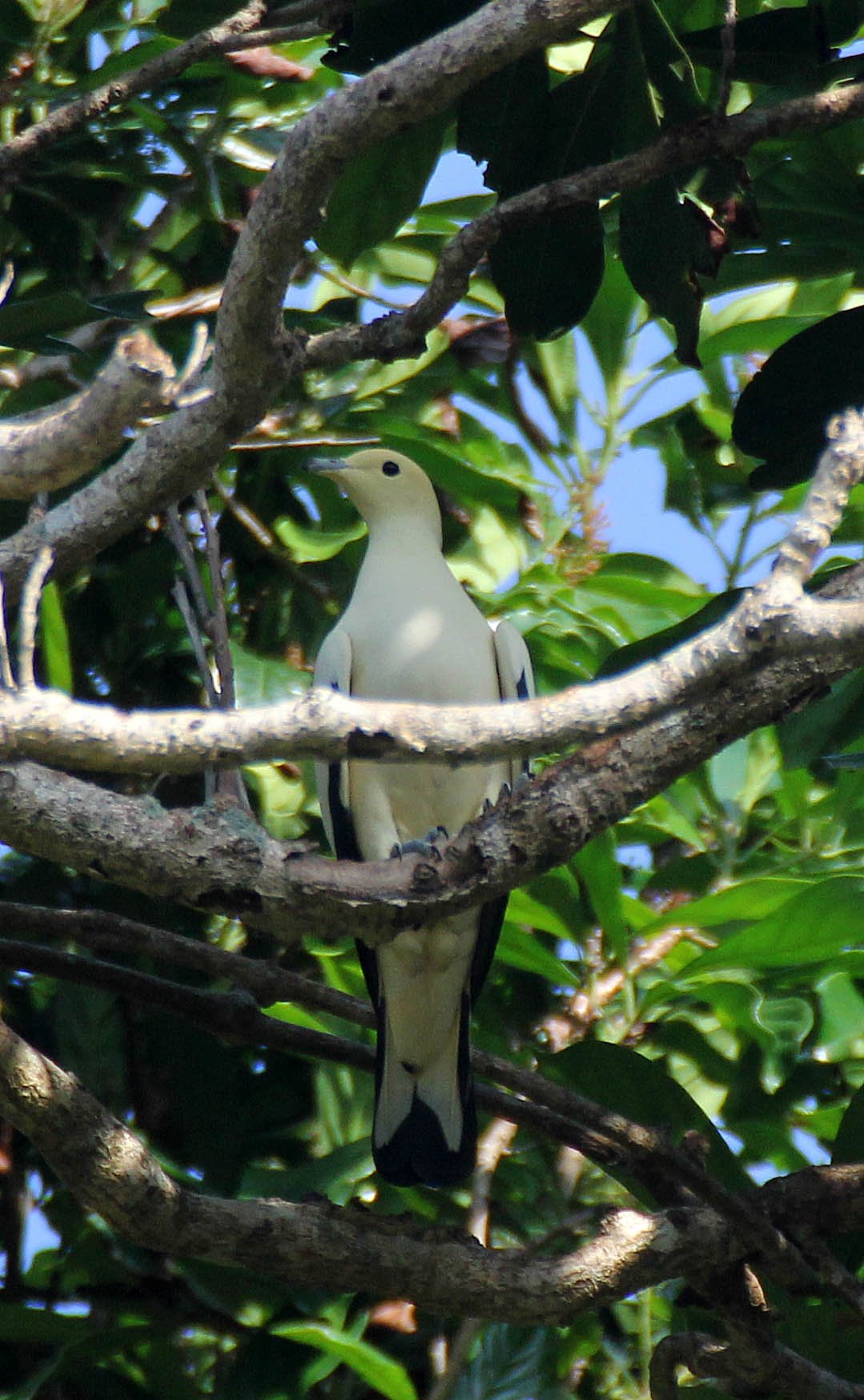Family Columbidae - Doves & Pigeons
Grey-headed Emerald Doves are common in the forests of Thailand
Columbidae is a bird family consisting of doves and pigeons. It is the only family in the order Columbiformes. These are stout-bodied birds with short necks and short slender bills that in some species feature fleshy ceres. They primarily feed on plants, and can be taxonomically divided amongst granivores, that feed mostly on the ground on seeds, and frugivores, that feed mostly on fruits, from branches. The family occurs worldwide, often in close proximity with humans, but the greatest variety is in the Indomalayan and Australasian realms.
Columbidae contains 344 species divided into 50 genera. 59 species are listed as threatened, and thirteen are extinct, including the dodo, an island bird, and the passenger pigeon, the only bird species not restricted to a small island to go extinct in modern times, even though its flocks were counted in the billions.
Mostly only by English speakers, the smaller species tend to be called "doves", and the larger ones "pigeons",[3] although the distinction is not consistent, and there is no scientific separation between them. Historically, the common names for these birds involve a great deal of variation. The bird most commonly referred to as "pigeon" is the domestic pigeon, or rock dove, which is common in many cities as the feral pigeon.
Doves and pigeons build relatively flimsy nests, often using sticks and other debris, which may be placed on branches of trees, on ledges, or on the ground, depending on species. They lay one or (usually) two white eggs at a time, and both parents care for the young. Unlike most birds, both sexes of doves and pigeons produce "crop milk" to feed to their young, secreted by a sloughing of fluid-filled cells from the lining of the crop.
Unfledged baby doves and pigeons are called squabs and are generally able to fly by 5 weeks of age. These fledglings, with their immature squeaking voices, are called squeakers once they are weaned, and leave the nest after 25–32 days.
Western Crowned-Pigeon (Goura cristata) Woodland Park Zoo Seattle Washington
Nicobar Pigeon (Caloenas nicobarica) Similan Islands Marine Park Thailand
European Turtle-Dove (Streptopelia turtur) Yang Country China
Laughing Dove (Streptopelia senegalensis) Karoo NP South Africa
Oriental Turtle-Dove (Streptopelia orientalis) Foping Nature Reserve, Shaanxi China
Red-collared Dove (Streptopelia tranquebarica) Bang Khaem Wetlands Nakhon Pathom
Eurasian Collared Dove (Streptopelia decaocto) Sunset Beach State Park California
Red-eyed Dove (Streptopelia semitorquata) Saint Lucia Nature Reserve South Africa
Ring-necked Dove (Streptopelia capicola) Etosha National Park Namibia
African Mourning Dove (Streptopelia decipiens) Langano Lake Ethiopia
Dusky Turtle-Dove (Streptopelia lugens) Ali Dege Plains Ethiopia
African Green-Pigeon (Treron calvus) Okavango Delta Botswana
Madagascar Green Pigeon (Treron griveaudi) Mantadia NP Madagascar
Orange-breasted Green-Pigeon (Treron bicinctus) Udawalawa NP Sri Lanka
Pink-necked green pigeon (Treron vernans) Tangkoko NP Sulawesi Indonesia
Sri Lanka Green-Pigeon (Treron pompadora) Srigiriya Forest Sri Lanka
Thick-billed Green Pigeon (Treron curvirostra) Kapok Kapien Station Huai Kha Khaeng Nature Reserve Thailand
Wedge-tailed Green Pigeon (Treron sphenurus) Doi Inthanon NP Chiang Mai
Yellow-footed Green Pigeon (Treron phoenicopterus) Gir Forest Sasan Gir Gujarat India
Large Green Pigeon (Treron capellei) Tabin Wildlife Reserve Borneo
Band-tailed Pigeon (Patagioenas fasciata) San Isidro Lodge, Eastern Andes, Ecuador
Black-winged Ground-dove (Metriopelia melanoptera) Lauca National Park, Chile
Brown Cuckoo-Dove (Macropygia phasianella) Nantu Nature Reserve Sulawesi Indonesia
Emerald-spotted Wood Dove or Greenspotted (Turtur chalcospilos) Imfolozi NP South Africa
Common Ground Dove (Columbina passerina) Loreto Baja Mexico
Ruddy Ground Dove (Columbina talpacoti) Illeus, Bahia Brazil, Una Township Area
Scaled Dove (Columbina squammata) Porto Alegre Lodge, Pantanal
Eared Dove (Zenaida auriculata) Fazenda Garibaldi, Sao Paulo State
Galapagos Dove (Zenaida galapagoensis) Galapagos Island NP Ecuador
Mourning Dove (Zenaida macroura) Franklin Mountains State Park Texas Tom Mays Unit
White-winged Dove (Zenaida asiatica) Davis Mountains State Park Texas
Gray-fronted Dove (Leptotila rufaxilla) Porto Alegre Lodge, Pantanal
Green Imperial-Pigeon (Ducula aenea) Tholpetty Reserve Wayanad Kerala India
Mountain Imperial-Pigeon (Ducula badia) Kaeng Krachan Phanoen Thung
Pied Imperial-Pigeon (Ducula bicolor) Similan Islands Marine Park Thailand
Silver-tipped Imperial-Pigeon (Ducula luctuosa) Tangkoko NP Sulawesi Indonesia
Grey Imperial Pigeon (Ducula pickeringi) Tabin Wildlife Reserve Borneo
Pink-bellied Imperial-Pigeon (Ducula poliocephala) Nantu Nature Reserve Sulawesi Indonesia
Long-tailed Ground-Dove (Uropelia campestris) Pantanal, Pouso Alegre Lodge, Brazil
Madagascar Blue Pigeon (Alectroenas madagascariensis) Ranomafana NP Madagascar
Malagasy Turtle-Dove (Nesoenas picturatus) Berenty Reserve Madagascar
Namaqua Dove (Oena capensis) Ali Dege Plains Ethiopia
Peaceful Dove (Geopelia placida) Pathum Thani Rice Research Center Thailand
Zebra Dove (Geopelia striata) Pathum Thani Rice Research Center Thailand
Plumbeous Pigeon (Patagioenas plumbea) Santa Teresa, Melo Leitao Museum Gardens
Sulawesi Black Pigeon (Turacoena manadensis) Nantu Nature Reserve Sulawesi Indonesia
Hill Pigeon (Columba rupestris) Hemis National Park Ladakh Jammu & Kashmir India
Nilgiri Wood-Pigeon (Columba elphinstonii) Pambadum Shola NP Kerala India
Rock Pigeon or Feral Pigeon (Columba livia) Gir Forest Gujarat India
Sri Lanka Wood-Pigeon (Columba torringtoniae) Nuwara Eliya Horton Plains Sri Lanka
White-collared Pigeon (Columba albitorques) Simien Mountains NP Ethiopia

Picazuro Pigeon (Patagioenas picazuro) Carlos Botelho State Park, Sao Paulo State Brazil
Little Green Pigeon (Treron olax) Hala Bala Thailand




















































